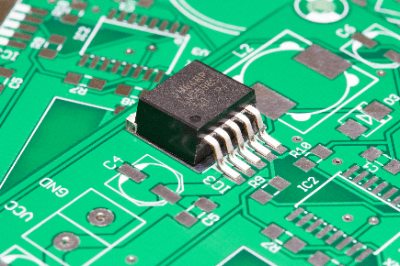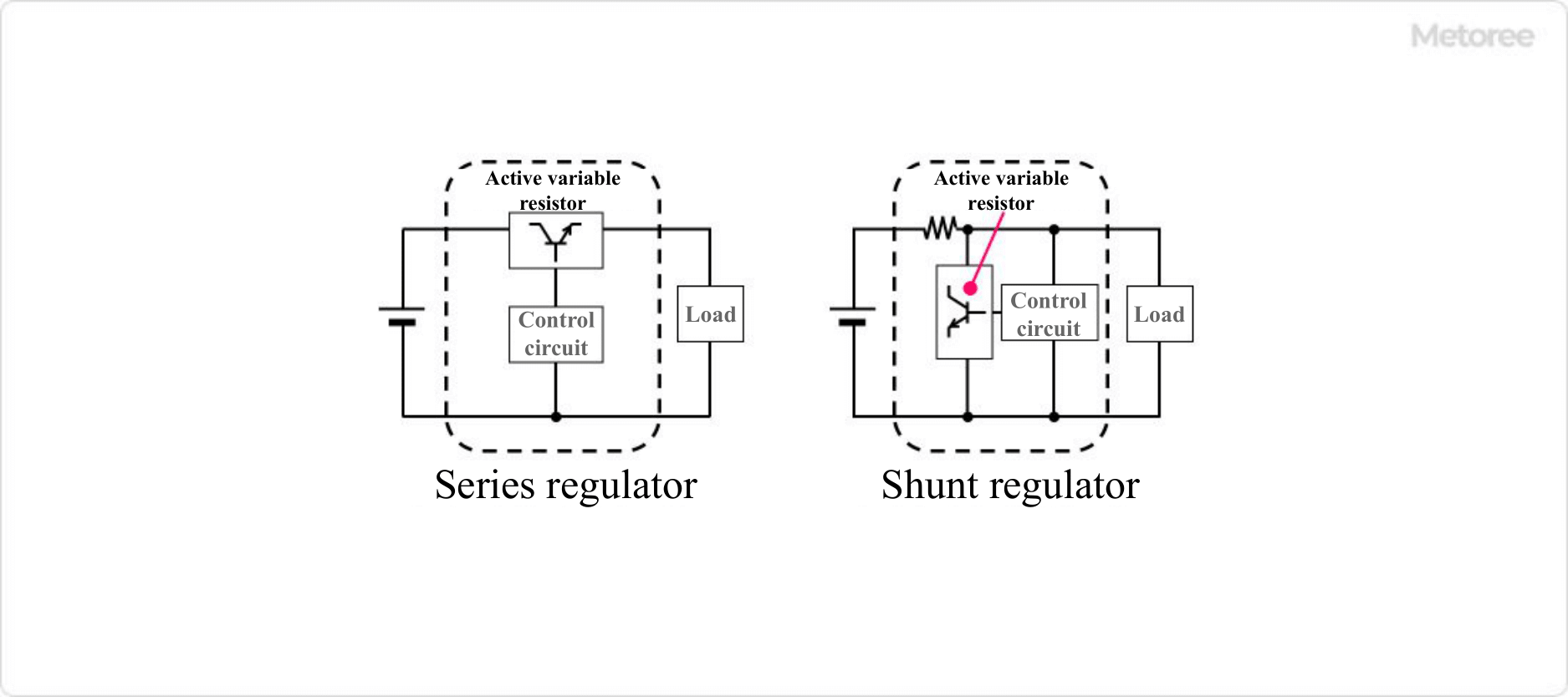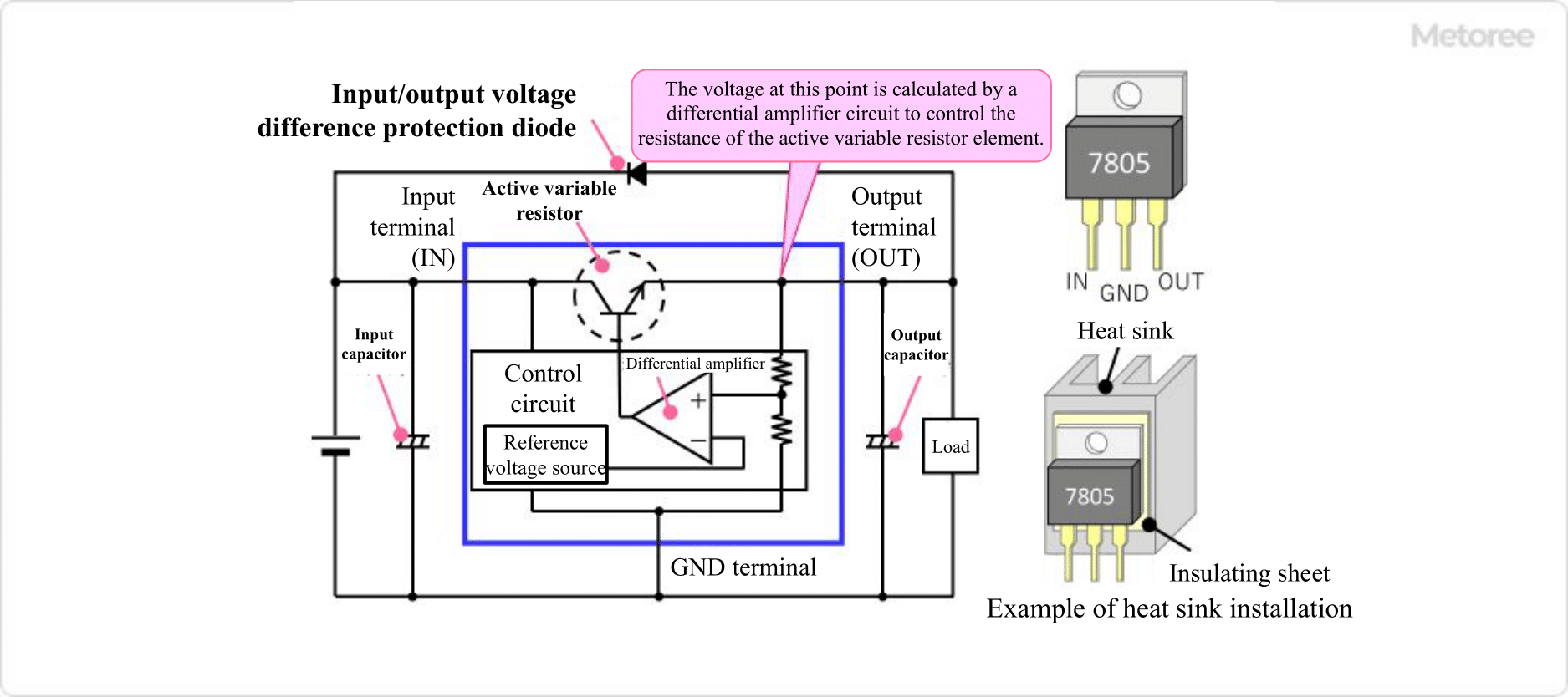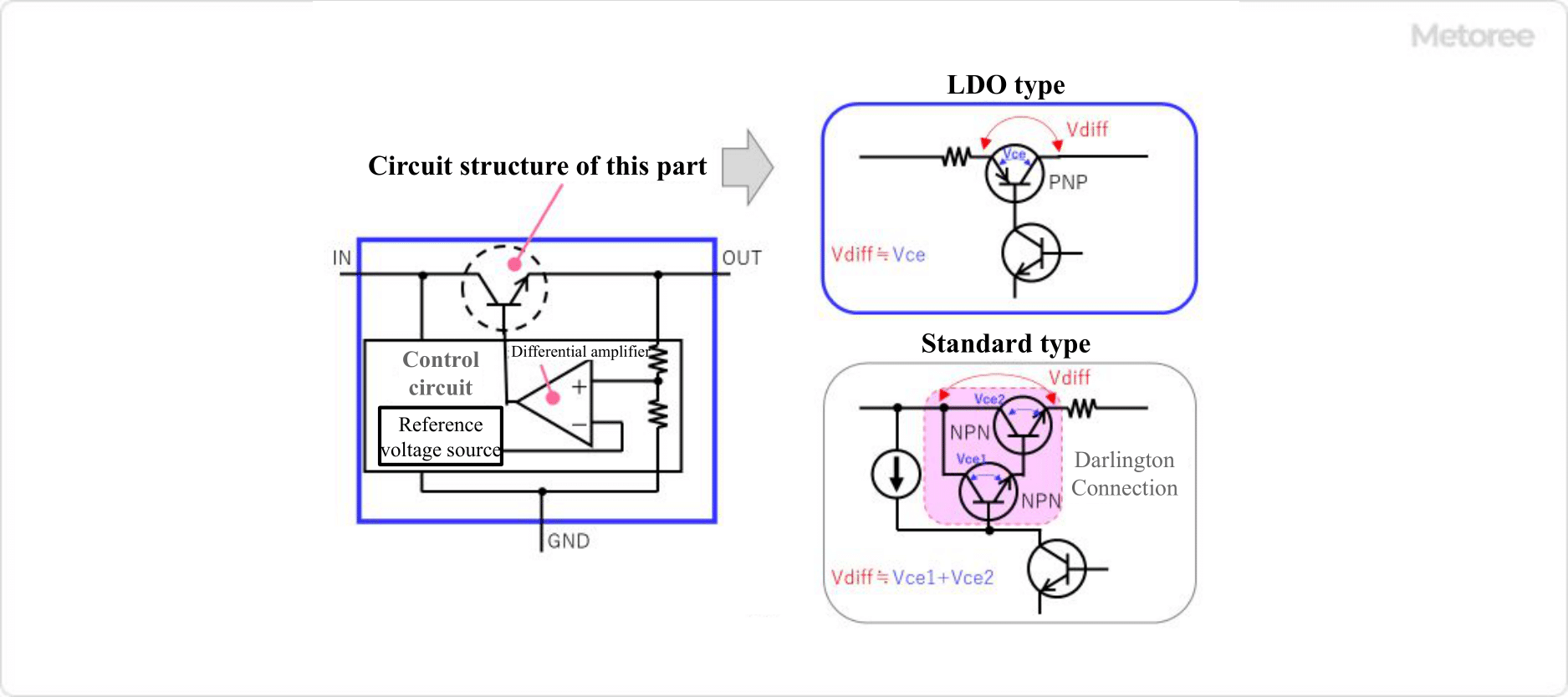All Categories
History












This section provides an overview for ic linear regulators as well as their applications and principles. Also, please take a look at the list of 20 ic linear regulator manufacturers and their company rankings. Here are the top-ranked ic linear regulator companies as of December, 2025: 1.WIN SOURCE ELECTRONICS, 2.PREMA Semiconductor GmbH, 3.Cissoid.
Table of Contents
Categories Related to IC Linear Regulators


Figure 1. Types of linear regulators
A Linear Regulator IC is an electronic component that outputs a stable voltage.
A constant voltage is output from the output terminal by using the voltage drop of a resistor or semiconductor device in relation to the input voltage. Since a small output voltage relative to the input voltage results in a large voltage difference loss, linear regulator ICs are used as power supplies for circuits and sensors that operate with low power consumption.
Among Linear Regulator ICs, a series regulator is an active variable resistor IC using semiconductor elements connected in series, and a shunt regulator is an active variable resistor IC connected in parallel.
Linear Regulator ICs are used as the power supply part of electronic equipment and precision instruments that operate on low power. Because of the simplicity of their circuits, many products are available in low price ranges, and they are characterized by excellent stability of the voltage of the power supply they supply and low noise.
Among Linear Regulator ICs, Series Regulator ICs should not exceed the absolute maximum operating temperature of the IC because of the heat generated during the voltage drop with active variable resistor elements. If the regulator IC generates a lot of heat, measures such as attaching an external heat sink must be taken if necessary.
Linear Regulator ICs are one of the most common 3-terminal regulators. 3-terminal regulators have three terminals: input, output, and ground. 3-terminal regulators have the same basic structure.
A power supply is connected to the input terminal, an input capacitor is connected between the input terminal and ground, and an output capacitor is connected between the output terminal and grant so that a constant voltage is output from the output terminal.

Figure 2. Principle of the three-terminal regulator
Inside a Linear Regulator IC is a control circuit consisting of an active variable resistor element using transistors or FETs and a reference voltage source. The control circuit measures the voltage passing through the active variable resistor element, performs feedback control, and controls the resistance value of the active variable resistor element, thereby controlling the magnitude of the voltage output from the output terminal to a certain level.
Because active variable resistor elements generate a voltage drop above a certain voltage, an input voltage that exceeds the minimum difference between the input voltage and output voltage, called the dropout voltage, is required to output a stable power supply. Normally, this is about 1.5 V. However, the IC should be selected with attention to the minimum input voltage.
Heat Dissipation of 3-Terminal Regulators
The product of the voltage difference between the input and output terminals and the current flowing from the output terminal (output current) generates heat inside the regulator and consumes power. Therefore, the larger the difference between input voltage and output voltage, and the larger the output current, the more heat is generated.
Therefore, heat dissipation design is an important factor when using 3-terminal regulators. To dissipate heat efficiently, an appropriate heat sink should be designed and attached to the 3-terminal regulator.
Board Design of 3-Terminal Regulators
The 3-terminal regulator operates to constantly output a stable voltage by feeding back the output voltage. Therefore, the capacitors connected between the input pin and GND and between the output pin and GND are very important. In particular, if the capacitor on the output pin is not appropriate, the output voltage may be transmitted.
In general, the capacitor recommended by the manufacturer of the 3-terminal regulator should be selected, but even in this case, the capacitor should be placed as close to the 3-terminal regulator as possible, and the board pattern between the 3-terminal regulator and the capacitor should be shortened in the board design.
Protection of 3-Terminal Regulator
If some abnormal voltage is expected to be applied to the input or output, a circuit to protect the 3-terminal regulator is required. If there is a possibility that an instantaneous high voltage may be applied to the input side, add a damping resistor or a Zener diode to the input to clamp that high voltage.
Countermeasures are also required when the input voltage may drop below the output voltage. If for some reason the input voltage drops significantly, a capacitor with large capacitance must be connected to the output terminals to maintain a constant output voltage. As a corollary, the output terminal voltage may temporarily be higher than the input terminal voltage when the power supply is turned off, for example.
Also, in a circuit that combines multiple power supplies, there is a possibility that the output voltage may be higher than the input voltage due to the power supply circulating from other power supplies. As a countermeasure, a protective diode (input side connected to cathode and output side connected to anode) can be added to allow current to flow from the output terminal to the input terminal.

Figure 3. Features of LDO-type regulators
Three-terminal regulators are classified into "standard type" or "LDO type" according to the magnitude of dropout voltage (the amount by which the output voltage drops relative to the input voltage).
The dropout voltage of the standard type is about 3.0V, while the LDO type is characterized by a dropout voltage of less than 1.0V, which is smaller than the standard type. LDO" is an abbreviation of "Low Drop Out. When the combination of 12V input voltage and 5V output voltage was common, 3-terminal regulators were widely used to convert 12V to 5V. In this case, standard regulators with a dropout voltage of about 3V could be used without problems.
However, when 3.3V digital ICs became mainstream and the input voltage was 5V and the output voltage was 3.3V, LDO-type regulators became indispensable to convert 5V to 3.3V on the board. The standard type output circuit using bipolar transistors consists of two NPN transistors with Darlington connections, but the LDO type output circuit uses a single PNP transistor. This allows operation with a small dropout voltage.
However, the negative feedback characteristics have also changed, and the LDO type has a narrower stable operating range and is more prone to oscillation than the standard type. Therefore, the capacitance and ESR (equivalent series resistance) characteristics of the capacitor connected to the output pin are extremely important factors for the LDO type.
*Including some distributors, etc.
Sort by Features
Sort by Area


Sensitron Semiconductor, founded in 1969 with corporate headquarters located in the USA, is a manufacturer of power electronic components and systems for the defense, aerospace, space, and medical markets. The company's products include high-power rectifier bridges, motion control modules, TVS modules, solid-state power controllers, and high voltage diode assemblies, as well as various services including, engineering, electrical and mechanical design, material science expertise, and testing of a finished power system. The company's facility includes a wafer fabrication clean room and a microelectronics manufacturing clean room.

Incorporated in 1965, Analog Devices, Inc. designs, manufactures, tests, and markets integrated circuits (ICs), software, and subsystems that leverage analog, mixed-signal, and digital signal processing technologies. The company provides data converter products, power management and reference products for power conversion, driver monitoring, sequencing, and energy management applications in the automotive, communications, industrial, and high-end consumer markets. In addition, the company provides digital signal processing and system products for high-speed numeric calculations. It serves clients in the industrial, automotive, consumer, instrumentation, aerospace, and communications markets.

Microchip Technology Incorporated was incorporated in 1989 and is headquartered in Chandler, Arizona. The company is a developer and manufacturer of control solutions for global markets including the automotive, industrial, communications, human-machine interface, and connectivity industries. The company’s products include microcontrollers, field-programmable gate array products, MOSFET and radio frequency products, and both wired and wireless communications products. The company’s services include wafer foundry and assembly services, test subcontracting manufacturing services, development tools for enabling system designers to program microcontrollers and processors, and timing system products.

PREMA Semiconductor, founded in Germany, in 1970 is a manufacturer of semiconductors. The company's product portfolio includes Microprocessors and Microcontrollers, Memory Devices, Analog and Digital Integrated Circuits, power management solutions and RF and Wireless Semiconductors. Their products are used in markets such as Automotive and Transportation, Telecommunications, Industrial Automation, Healthcare and Medical Devices and Aerospace and Defense. The company provides services such as Product Selection Guidance, prototyping, New Product Design and Development and Custom Manufacturing.

Cissoid, founded in 2000 and headquartered in Mont-Saint-Guibert, Walloon Region, is a manufacturer of high temperature semiconductors. They deliver standard products and custom solutions for power management, power conversion and signal conditioning in extreme temperature and harsh environments. Their solutions range from system-on-chip to complete SiC and GaN based inverter platforms to support an ever-growing range of e-mobility and high-power applications. The company has been supplying products to leaders in the Oil & Gas, aeronautic, Industrial and automotive markets.



Toshiba Electronic Devices & Storage Corporation is a division of Toshiba focusing on providing designs for end-product developers as well as semiconductor and drive equipment for automotive, industrial equipment, green energy, and consumer and personal electronic devices. Toshiba’s storage products include cloud-scale and enterprise-level products, and PC hard drives. Semiconductor products include Si Cower devices, MOSFETs, IGBTs, IEGTs, isolators, solid state relays, power management and intelligent power ICs, diodes, bipolar transistors, microcontrollers, automotive devices, ICs for wireless communication equipment, general purpose logic ICs, radio-frequency devices, sensors, and linear image sensors.

Renesas Electronics Corporation was established in 2002 and is headquartered in Tokyo, Japan. Renesas is a global research, design, and manufacturer of semiconductors used in industries spanning automotive, consumer electronics, the internet of things, power & energy, and industrial sectors. Renesas manufactures both analog and digital products. Analog products include amplifiers, audio & video devices, data converters, PLC, and switches & multiplexers. Digital products include microcontrollers, memory components, sensors, wireless connectivity products, and others. Renesas also offers design resources such as kits, development tools, partner programs, and design tools.



Continental Device India Pvt. Ltd. (CDIL), established in 1964, is a semiconductor manufacturer headquartered in New Delhi, India. Certified with ISO 9001:2015 and ISO 14001, the company produces TRIACs, SCRs, and TVSs. It also offers complementary products, including diodes, rectifiers, and transistors. These products adhere to the European Union's Restriction of Hazardous Substances in Electrical and Electronic Equipment (RoHS) Directives. The company expanded its services by launching the Electronic Manufacturing Services (EMS) division, Deltron, in 1982. It also manufactures space-grade semiconductor devices for the Indian Space Research Organisation (ISRO).

Monolithic Power Systems (MPS), founded in 1997 and headquartered in San Jose, California, is a manufacturer of integrated circuits (ICs). Their product range includes switch-mode power supplies (SMPS) for converting AC or DC power to lower voltage DC power, LED drivers for driving LED lights, battery management ICs to manage power in portable devices, power factor correction (PFC) ICs for improving power supply efficiency, and sensorless motor control ICs to control motors without position sensors. MPS's solutions find applications in consumer electronics, industrial, and automotive industries, offering efficient power management solutions to enhance various electronic devices.

ABLIC, Inc. is a manufacturer of analog semiconductors and integrated circuits (ICs) based in Minato-ku, Tokyo. Originally established in 2016, the company is a subsidiary of Seiko Instruments, Inc., and was renamed SII Semiconductor Corporation in 2018. The company produces memory, logic, and power management ICs, as well as various sensors for use in mobile computers, industrial equipment, wearable tech, and automotive systems. These supply clients in the consumer electronics, factory automation, and medical equipment industries.

ST Micro Electronics is a global semiconductor company serving customers with innovations to have a positive impact on people's lives. Their product line is micro electronic systems, such as switches, controllers, sensors and drivers. The main selling point of ST Micro Electronics is its provision of sustainable products, and introducing their electronics to create a more sustainable world. The company, as well as providing the electronic devices, also provides software and support, ensuring that all fields are covered to provide a fully provide a supported and strong relationship with their customer base. ST Micro Electronics believe that technology plays a key role in helping to solve environmental and social challenges, which is why their semiconductor technologies start with their employees, their customers and partners.

Texas Instruments Incorporated was founded in 1930 and is headquartered in Dallas, Texas. Texas Instruments is a producer of high tech equipment for industrial, automotive, personal electronics, communications equipment industries. Texas Instruments designs, manufactures, and sells semiconductors to electronics designers and manufacturers in the United States and internationally. Texas Instruments operates in two segments: analog and embedded processing. The Analog segment offers power products, including battery-management solutions, DC/DC switching regulators, power switches, linear regulators, voltage references, and lighting products. The Embedded Processing segment offers microcontrollers that are used in fields such as electronic equipment and digital signal processors for mathematical computations.

WIN SOURCE is meticulously amassing electronic components, through refined procedures, first-rate services, diverse portfolios, intellectual investments, and expanding business globally. It caters to regular parts costdown needs, and obsolescence management, and focusing on customer satisfaction, offers a seamless, customized approach to optimize your supply chain, and experience supply chain solutions precisely designed to align with your unique needs, ensuring efficiency, flexibility, and cost-effectiveness. Web:win-source.net | win-source.group Email:service@win-source.net Global Branches :United States | Germany | Canada | Italy | Singapore | India | Japan | United Kingdom | South Korea | Hong Kong | Mainland China | Philippines

Taiwan Semiconductor, established in 1979 in Taiwan, is a manufacturer and distributor of integrated circuits and wafer semiconductor devices for commercial and industrial customers worldwide. The company's product line includes discrete power rectifiers, power transistors, LED driver ICs, analog ICs, and ESD protection devices. Taiwan Semiconductor has production facilities in China and Taiwan that are compliant with automotive and environmental standards, including IATF 16949, ISO 9001, and ISO 14001. Taiwan Semiconductor is also a member of the ECIA and the PSMA.

Trex Semiconductor is a developer and manufacturer of integrated circuit (IC) products that was established in Tokyo, Japan, in 1995. The company offers voltage regulator ICs for providing stable voltage output from variable input voltage, DC/DC converter ICs for power management applications, and hall ICs for detecting magnetic fields and outputting digital signals. It also offers design and production services for custom orders or unique projects. The company mainly serves client OEMs in the automotive, consumer electronics, and power distribution industries.

Ranking as of December 2025
Derivation Method| Rank | Company | Click Share |
|---|---|---|
| 1 | WIN SOURCE ELECTRONICS |
22.3%
|
| 2 | HAOXIN HK ELECTRONIC TECHNOLOGY CO. LIMITED |
9.4%
|
| 3 | PREMA Semiconductor GmbH |
9.4%
|
| 4 | Cissoid |
9.4%
|
| 5 | Continental Device India Pvt. Ltd. |
7.2%
|
| 6 | Legend Enterprises |
5.8%
|
| 7 | Sensitron Semiconductor |
5.8%
|
| 8 | Campus Component Private Limited. |
5.0%
|
| 9 | Microchip Technology Inc. |
3.6%
|
| 10 | ABLIC Inc. |
3.6%
|
Derivation Method
The ranking is calculated based on the click share within the ic linear regulator page as of December 2025. Click share is defined as the total number of clicks for all companies during the period divided by the number of clicks for each company.Number of Employees
Newly Established Company
Company with a History
*Including some distributors, etc.
*Including some distributors, etc.
| Country | Number of Companies | Share (%) |
|---|---|---|
 Japan
Japan
|
5 | 33.3% |
 United States of America
United States of America
|
3 | 20.0% |
 India
India
|
3 | 20.0% |
 Germany
Germany
|
1 | 6.7% |
 Belgium
Belgium
|
1 | 6.7% |
| United States | 1 | 6.7% |
 Taiwan
Taiwan
|
1 | 6.7% |
45 products found
45 products
Sanshin Electric Co., Ltd.
430+ people viewing
■Features ・Small surface mount package (SOT-89-5) ・Output current 250mA ・Low current consumption Iq (OFF) ≦1μA (VC=0V) ・Low loss VDIF≦0.5V (at ...
Sanshin Electric Co., Ltd.
420+ people viewing
Last viewed: 5 hours ago
Nisshinbo Micro Devices Inc.
720+ people viewing
Last viewed: 13 hours ago
■Summary NR1700 is a 42V, 200mA voltage regulator using a CMOS process. The output voltage can be set arbitrarily within the range of 1.2V to 24V u...
Nisshinbo Micro Devices Inc.
560+ people viewing
Last viewed: 17 hours ago
■Summary NJW4250 is a 45V voltage tracker with IOUT=50mA. The tracking voltage is programmable from 2.5V to 36V and is ±5mV over the entire operati...
Nisshinbo Micro Devices Inc.
630+ people viewing
Last viewed: 3 hours ago
■Summary MUSES100 is a 5.5V, 600mA voltage regulator for high quality audio equipment using a CMOS process. MUSES100 achieves high sound quality us...
Nisshinbo Micro Devices Inc.
620+ people viewing
Last viewed: 21 hours ago
■Summary R1560 is an ultra-low power voltage regulator that can input up to 60V and output 100mA. It has a built-in short circuit current limit cir...
Nisshinbo Micro Devices Inc.
670+ people viewing
Last viewed: 1 day ago
■Summary R1561 is a low consumption voltage regulator that can input up to 60V and output 100mA. It has a built-in short circuit current limit circ...
Nisshinbo Micro Devices Inc.
610+ people viewing
Last viewed: 20 hours ago
■Summary R5116 is a system power supply that combines a 500mA voltage regulator with an input voltage of 3.5V to 42V and a window voltage detector ...
Nisshinbo Micro Devices Inc.
620+ people viewing
Last viewed: 22 hours ago
■Summary R5117 is a system power supply that integrates a battery voltage monitoring voltage detector with an input voltage of 3.5V to 42V, a sense...
Nisshinbo Micro Devices Inc.
610+ people viewing
Last viewed: 1 day ago
■Summary The R1526 series is a 300 mA voltage regulator with a maximum input of 42 V. It has excellent resistance to external electromagnetic noise...
Nisshinbo Micro Devices Inc.
720+ people viewing
Last viewed: 1 day ago
■Summary R1525 is a low consumption voltage regulator that can input up to 42V and output 200mA. It has excellent resistance to external RF noise, ...
Nisshinbo Micro Devices Inc.
570+ people viewing
Last viewed: 21 hours ago
■Summary The R5112 series is a voltage regulator with an ultra-low power consumption detector that can input 42V and output 200mA. In addition to t...
Keisei Co., Ltd.
290+ people viewing
Last viewed: 16 hours ago
Monolithic Power Systems, Inc.
260+ people viewing
Last viewed: 9 hours ago
■Summary The MP2000 is a low voltage, low dropout bipolar linear regulator. It operates from an input voltage of 1.35V to 6.0V and adjusts the outp...
Monolithic Power Systems, Inc.
330+ people viewing
■Summary The MPQ2022A-AEC1 is a dual-channel low-dropout (LDO) regulator with digital interface and memory. The device provides phantom power to lo...
Monolithic Power Systems, Inc.
320+ people viewing
Last viewed: 5 hours ago
■Summary MPQ2019 is a low power linear regulator that powers systems with high voltage batteries. Features a wide 3V to 40V input range, low dropou...
Monolithic Power Systems, Inc.
330+ people viewing
Last viewed: 1 day ago
■Summary The MPQ2013D-AEC1 is a low power linear regulator that powers systems with high voltage batteries. The device features a wide input voltag...
Monolithic Power Systems, Inc.
270+ people viewing
Last viewed: 3 hours ago
■Summary The MPQ2013A is a low power linear regulator that powers systems with high voltage batteries. Features a wide 2.5V to 40V input range, low...
Monolithic Power Systems, Inc.
200+ people viewing
Last viewed: 14 hours ago
■Summary The MP161 integrates a 700V switching regulator, a low-dropout linear regulator, and a 2-channel relay driver. MP161 also has a special st...
Monolithic Power Systems, Inc.
280+ people viewing
Last viewed: 22 hours ago
■Summary The MP2013A is a low power linear regulator that powers systems with high voltage batteries. Features a wide 2.5V to 40V input range, low ...
Monolithic Power Systems, Inc.
200+ people viewing
■Summary The MP161 integrates a 700V switching regulator, a low-dropout linear regulator, and a 2-channel relay driver. MP161 also has a special st...
Monolithic Power Systems, Inc.
290+ people viewing
■Summary The MP2015A is a low power linear regulator that powers systems with high voltage batteries. Features a wide 2.5V to 24V input range, low ...
Monolithic Power Systems, Inc.
190+ people viewing
Last viewed: 13 hours ago
■Summary MP100L is a small, inductorless, high efficiency offline regulator. Steps down AC line voltage to adjustable DC output. A simple solution ...
Monolithic Power Systems, Inc.
290+ people viewing
■Summary The MP2019 is a low power linear regulator that powers systems with high voltage batteries. Features a wide 3V to 40V input range, low dro...
Monolithic Power Systems, Inc.
230+ people viewing
Last viewed: 2 hours ago
■Summary The MP103 provides a simple, low-cost AC/DC solution for sub-1W applications. This is an offline linear regulator that generates almost no...
Monolithic Power Systems, Inc.
320+ people viewing
Last viewed: 1 day ago
■Summary MPQ2019 is a low power linear regulator that powers systems with high voltage batteries. Features a wide 3V to 40V input range, low dropou...
Monolithic Power Systems, Inc.
250+ people viewing
Last viewed: 7 hours ago
■Summary The MP163 is a primary-side regulator that provides accurate output, dual output, and constant voltage (CV) regulation without an optocoup...
Monolithic Power Systems, Inc.
330+ people viewing
Last viewed: 1 day ago
■Summary The MP2014 is a low power linear regulator that powers systems with high voltage batteries. Features a wide 3V to 40V input range, low dro...
Monolithic Power Systems, Inc.
230+ people viewing
■Summary The MP175L is a primary-side regulator that provides accurate constant voltage (CV) regulation without an optocoupler. MP175L supports buc...
Monolithic Power Systems, Inc.
260+ people viewing
Last viewed: 18 hours ago
■Summary The MPQ2013A is a low power linear regulator that powers systems with high voltage batteries. Features a wide 2.5V to 40V input range, low...